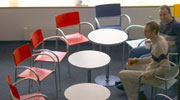Teaching
Teaching Winter Semester 2001/02
Computergraphik
(Stammvorl. Praktische Informatik)
 |
 |
 |
 |
 |

Animation courtesy of Michael Hemmer and Lübomira Spassova |
Computer graphics includes a wide range of applications, from 2D and
3D-graphics, multimedia and computer-generated films up to interactive
computer games and virtual reality. Despite the large variety of
applications the same problems occur everywhere again and again, for
which this lecture presents fundamental techniques and solution
strategies.
-
Topics covered
- This lecture is an introduction to computer graphics, which will
concentrate on fundamental principles and illustrate them with
different application examples. Among other things, topics such as in-
and output devices, optical perception, rasterisation, anti-aliasing,
transformations, clipping, visibility, shading and lighting
calculation are addressed. Basis of programming is the graphic standard
OpenGL and RenderMan.
-
Obtained abilities
- The target of the lecture is it to provide an overview of the tools
in computer graphics, to present fundamental techniques and algorithms
and become acquainted with a range of application scenarios in computer
graphics.
-
Date/Location
-
Tuesday and Wednesday 9-11
-
HS II, Geb. 45
-
Lecturer
-
Seidel, H.-P., Myszkowski,
K.
-
Coordinator for assignments
-
J. Kautz
-
Lecture is part of
-
Stammvorlesung Praktische Informatik
-
Prerequisits
-
none
-
Possible followups
- seminars, special lectures ("Spezialvorlesungen"), FoPras in
computer graphics.
-
Grading
-
Weekly assignments
- To be admitted to the final exam you have to have 30% on every assignment
sheet but one, and a total of 50% of the points of all assignments.
- Groups of up to two people are allowed for the weekly
assignments. If you work together please submit only one assigment and
put both names on your assignment sheet.
- You must be able to explain your solutions in the excersise
groups (and you might be asked to do so).
-
Rendering-Competition (30%)
-
The goal is to create photorealistic images.
-
The rendering software will be the Blue Moon Rendering Toolkit (BMRT).
-
Final exam (70%)
[an error occurred while processing this directive]
-
Mailinglist
-
Excersise groups
- Tuesday 14-16, 022/46.1 (MPI)
- Wednesday 9-11, 022/46.1 (MPI)
- Wednesday 16-18, 021/46.1 (MPI)
Literature
-
Alan Watt, 3D Computer Graphics, Addison-Wesley, 1999, 112 DM
-
James Foley, AndriesVan Dam, et al., Computer Graphics : Principles and
Practice, 2. Ausgabe, Addison-Wesley, 1995, 131 DM
-
Andrew Glassner, Principles of Digital Image Synthesis, 2 Bände, Morgan
Kaufman, 1996, 193 DM
-
Andrew Glassner, An Introduction to Ray-Tracing, Academic Press, 1989,
$71
-
Andrew Woo, et al., OpenGL Programming Guide, 3. Ausgabe, Addison-Wesley,
1999, 93 DM
-
Remarks:
-
Lecture starts on Tuesday, October 23rd.
-
The lectures will be given in English








